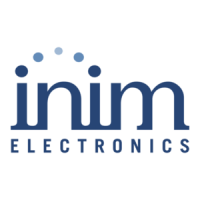Installation and programming manual
Options and programming methods 67
• NoArmIfNotReady. If this option is enabled, the zone, even if it is a 24H,
automation or delayed zone, will not arm when it is not in standby status. This
option, for 24H or automation zones, can be used for the management of the “anti-
mask” function of detectors which have this feature.
Partitions which at the moment of arming have open zones with this option enabled,
will not be armed; instead, the system will generate a failed arming even (“Failed to
arm”).
• Delay time 2. If this option is enabled, delayed zones will activate the second
partition entry time. If this option is not enabled, delayed zones will activate the first
partition entry time.
• Last exit zone. If this option is enabled, and the zone passes from standby status
to alarm status while the partition exit time is running, the exit time will be forced to
15 seconds. If the zone passes from alarm status to standby status, the exit time
will be forced to 5 seconds.
• UnbypassOnDisarm. If this option is enabled, a zone which has been bypassed by
a user, will be automatically unbypassed when the partition next disarms.
• Hold-up.
• Fault zone. If this option is enabled, violation of the zone will generate a zone alarm
event and contribute to fault signalling (yellow LED on the keypad).
• Disable tamp. WLS. If this option is disabled, open/dislodgement tamper on Air2
detectors will not generate the respective events.
ATTENTION!
Activation of this option will void compliance with current regulations.
Wireless
Note
Please note that this section will be operative only when the zone you are working on is
configured as a wireless zone (refer to paragraph 7-6 Terminals).
This section allows you to carry out all the operations relating to the programming of
Air2 wireless series devices. The wireless-device programming section is arranged as
follows.
• Enroll device - allows you to enroll a wireless device not yet enrolled on the
terminal concerned.
Press to initialize the enrollment process. Select the type of detector you wish to
enroll:
•• Infrared sensor, allows you to enroll an Air2-IR100 detector
••
Magnetic contact
, allows you to enroll Air2-MC100 magnetic reed contact
•• Terminal T1 M.C., allows you to enroll the “T1” terminal of an Air2-MC100
•• Terminal T2 M.C., allows you to enroll the “T2” terminal of an Air2-MC100
•• Smoke detector, allows you to enroll an Air2-FD100 smoke detector
••
Magn.Cont.MC200
, allows you to enroll an Air2-MC200 device.
•• Curtain sensor, allows you to enroll an Air2-DT200T curtain detector
•• Curtain direction, allows you to set the direction of an Air2-DT200T
•• Double T. sensor, allows you to enroll an Air2-XDT200W dual technology
detector
•• Single T. sensor, allows you to enroll an Air2-XIR200W passive infrared detector
•• OutdoorDetector, allows you to enroll an Air2-OTT100W outdoor triple
technology detector, an Air2-ODI100W outdoor triple technology detector or an
Air2-UT100 universal wireless transceiver
After selecting the desired type, press . The first line of the keypad will show
the “Programming” string.
To enroll the wireless device, press and release its on-board “ENROLL” button. As soon
as the enrolling process is complete, the keypad will emit an audible signal (beep) to
confirm the operation, and will show (in accordance with the type of device) the
following:
• Delete detector, allows you to delete (unenroll) an enrolled wireless detector from
the terminal concerned
• Infrared sensor - allows you to change the parameters of the previously enrolled
Air2-IR100 or Air2-FD100 smoke detector If you press , it will be possible to
adjust the sensitivity of the detector by setting the required number:
•• Air2-IR100: from 1 (least sensitive) to 4 (most sensitive)
•• Air2-FD100:1=0.08 dB/m (pre-set mode); 2=0.10 dB/m; 3=0.12 dB/m ; 4=0.15
dB/m
1. Use keys and to select the field you wish to change, then use the number
keys ( , etc.) to edit the number.
Programming
Wireless
Enroll detector
Delete detector
Enroll detector
Infrared sensor
Magnetic Contact
Terminal T1 MC

